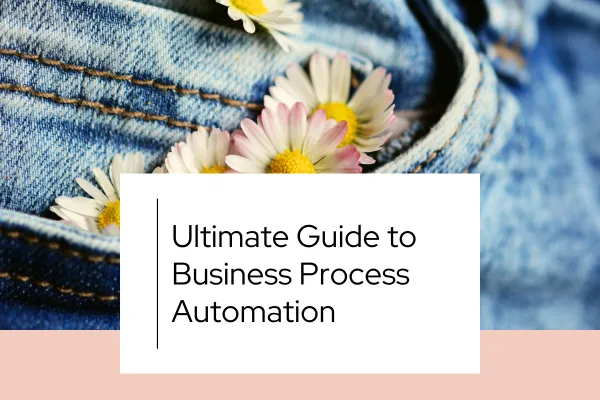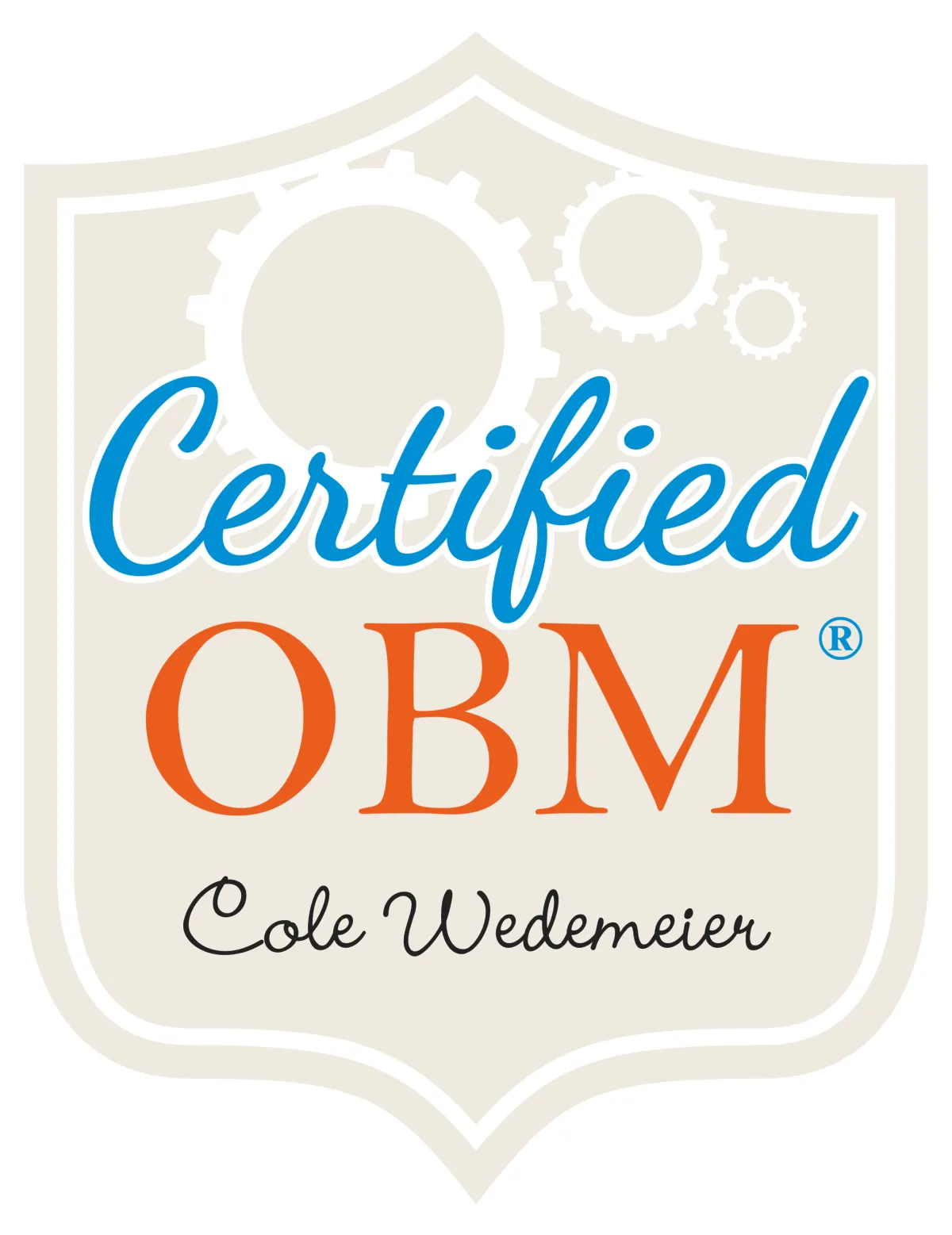

What is Business Process Automation? The Ultimate Guide to Business Process Automation
Small business owners are notoriously busy. With everything we have going on, it can be difficult to decide what needs to be delegated first and who the task should go to. Luckily, there’s another option outsourcing work to freelancers and assistants: business process automation. In this guide, I’ll share everything you need to know to get repetitive tasks off your plate, so you can focus on your area of genius. In fact, I’ve used this same knowledge to help dozens of clients automate their business processes and scale their companies with ease. Here’s what you need to know about business process automation.
What is Business Process Automation?
When I discuss Business Process Automation (BPA) with clients, I emphasize its essence in enhancing efficiency and productivity. It's about pinpointing tasks that we consistently perform the same way. Once these are identified, the goal is to introduce automation, which reduces or eliminates manual effort. This isn't just about personal time-saving but for the entire team. It's a method to decrease duplicated efforts and optimize operations in the business world. Ultimately, it's about streamlining processes and maximizing our valuable resources.
Want more info? Check out: Why Business Process Automation is a Game Changer for Online Service Providers
Why is Business Process Automation Important?
I believe business automation is crucial because it allows us to focus on activities we genuinely enjoy. Not many people, except those who are technology-savvy or detail-oriented, want to spend their time sending out emails, ensuring everyone has their contracts, or verifying that an invoice has been sent for an upcoming payment. Most business professionals, be it a copywriter or any other role, want to concentrate on their core job, not the repetitive, manual tasks required to run their business.
What is the Process of Business Automation?
When automating a business, I delve deep into its processes. Let's say you're a course creator who just completed a significant launch, bringing in a sizeable number of new students. I examine the process it entails for both you and your students: from welcome emails, contracts, payment plans, to intake forms. I then evaluate the tech stack in use, figuring out how different systems can communicate through intermediary software like Zapier or Integrately. The goal is to create a seamless flow, like a domino effect. When one action is completed, the next one is triggered automatically, eliminating manual intervention for tasks like sending out contracts or scheduling financial advisory meetings.
What are the Benefits of Business Process Automation?
Business Process Automation is like a magic tool for businesses. It helps things run smoothly by taking care of repetitive tasks, saving us loads of time and effort. Think about it: no more answering the same old customer questions over and over because automation handles it. This means happier customers, getting answers faster! Plus, with automation, all the important details, like client information or appointment dates, are kept spot on. Automation can drastically minimize human errors. And the best part? As your business grows, automation makes sure every new client gets the same great experience as the first. But don’t worry, it’s not about replacing people. It’s about making sure everyone's time is used for what they do best. So, instead of getting bogged down with the same tasks, teams can focus on the big picture stuff. All in all, it's a win-win for everyone!
Want to learn more? Check out my Top Five Benefits of Business Process Automation.
What are the Potential Disadvantages of Business Process Automation?
Business Process Automation offers various advantages, but it's not without its downsides. A primary concern is its potential impersonality. Without careful implementation, automation can distance businesses from their customers, making interactions feel generic. Another misconception is that automation can be "set and forget," but in reality, consistent monitoring and updating are crucial to ensure it aligns with evolving business needs. While automation can streamline operations, if misapplied, it can complicate processes, overwhelming both staff and clients. Lastly, small businesses might feel BPA is beyond their reach, not realizing there are cost-effective solutions tailored for their scale.
Want more? Check out: Disadvantages of Business Process Automation: Debunking the Common Misconceptions about Automation
Will Automation Make My Business Less Personal?
Contrary to common fears, automation doesn't necessarily make your business impersonal. Instead, it can enhance personalization when implemented thoughtfully. Automation, tailored to customer behavior like abandoned carts or achieved milestones, can lead to timely and relevant outreach. For instance, an automated email after a customer leaves items in their cart can serve as a gentle reminder, even offering a personalized discount. Segmentation, another facet of automation, ensures that communications align with a client's engagement history or interests. Knowing someone discovered your brand through a specific podcast or has a preference for professional attire can shape the automated messages they receive. Ultimately, it's not automation itself, but how it's used that determines the personal touch in business interactions. When executed right, automation can make interactions even more personal, showing customers that their preferences and journeys are noted and valued.
To learn more, check out: How to Maintain a Personal Touch while Automating Your Customer Service
What Should I Automate First?
The best starting point for automation is identifying where you spend most of your time daily. If you find yourself answering the same questions repeatedly or handling recurring tasks, those are prime candidates for automation. Once you begin automating one area and witness the benefits, it's like a light bulb moment. You'll realize other areas that can also benefit from automation, ultimately easing your workload.
Learn more here: Where to Start with Business Process Automation
Business Process Optimization Examples
Navigating the world of Business Process Automation can be overwhelming, but I've discovered several practices that can be genuine game-changers for any entrepreneur. Starting with a seamless onboarding process, I've automated client deliveries to save both time and energy. I also swear by having a bank of canned responses ready for those frequent customer questions. And don't get me started on the magic of setting up automated email reminders and follow-ups—it's been a game-changer for maintaining consistent client communication. Plus, tackling repetitive tasks and gathering feedback through automated systems makes everything smoother. And believe me, if you're not using automated invoicing yet, you're missing out! Embracing these automation examples, I've managed to achieve efficiency without losing that essential personal touch. Trust in automation—it's like having an extra pair of hands in this bustling business world.
Want more? Check out: 7 Business Process Automation Examples Every Business Owner Should Try
Can Business Process Automation Help with Business Analytics
Business Process Automation is more than just a tool—it's a game-changer for business analytics. By automating various processes, BPA provides businesses with real-time insights into the origin of leads, collaboration efficiency, and lead conversion rates. Additionally, it highlights popular products and services, helping businesses discern sales trends and demands. With BPA, one can also track the effectiveness of different payment plans, and even assess course engagement levels to refine content delivery. Beyond these specifics, BPA facilitates data-driven decision-making, ensuring businesses no longer rely on hunches but on concrete data. This leads to strategic planning and resource allocation tailored to actual needs and market behavior. In essence, BPA is the compass directing businesses on where to venture next, offering a profound advantage in the dynamic world of commerce. So, can BPA help with business analytics? Absolutely—it revolutionizes it.
Read more here: 8 Ways to Use Business Process Automation in Your Business Analytics
What are the Best Tools for Automation?
When it comes to streamlining and optimizing business processes, selecting the right automation tools is paramount. Website analytics tools like Google Analytics and Fathom are essentials, offering insights into traffic sources and helping you understand your audience's journey. CRMs such as Dubsado, Honeybook, and 17 Hats revolutionize client management by combining proposals, contract signing, and scheduling into one seamless process. Meanwhile, FG Funnels emerges as an all-in-one solution, managing websites, funnels, and email marketing campaigns with ease. However, the real game-changer in my toolbox has to be Airtable. It's a versatile database platform that not only tracks vital business metrics but also integrates automation, from client reminders to feedback solicitations. Each of these tools has been instrumental in enhancing efficiency and ensuring smooth operations, making them top recommendations for anyone venturing into business automation.
For more information, check out: The Best Tools for Business Process Automation
About Cole
I'm a mom of two with a deep love for all things tech, iced coffee, and spontaneous drives. My journey began in Corporate America, working to optimize systems and technology between the C-Suite leadership team and the US Government + Military division. Now, I’m the heart and soul behind "Blue Jeans Boss", on a mission to make automation in business feel accessible and friendly. My dream? A world where everyone feels confident navigating tech solutions without feeling bound by them. Dive into my world, and let's make tech simple together!
Learn more about me here: About Cole: Finding Simplicity in Tech's Complexity
Ready to put automation into practice for your business?
Reach out to me to learn more and get started!

What is Business Process Automation? The Ultimate Guide to Business Process Automation
Small business owners are notoriously busy. With everything we have going on, it can be difficult to decide what needs to be delegated first and who the task should go to. Luckily, there’s another option outsourcing work to freelancers and assistants: business process automation. In this guide, I’ll share everything you need to know to get repetitive tasks off your plate, so you can focus on your area of genius. In fact, I’ve used this same knowledge to help dozens of clients automate their business processes and scale their companies with ease. Here’s what you need to know about business process automation.
What is Business Process Automation?
When I discuss Business Process Automation (BPA) with clients, I emphasize its essence in enhancing efficiency and productivity. It's about pinpointing tasks that we consistently perform the same way. Once these are identified, the goal is to introduce automation, which reduces or eliminates manual effort. This isn't just about personal time-saving but for the entire team. It's a method to decrease duplicated efforts and optimize operations in the business world. Ultimately, it's about streamlining processes and maximizing our valuable resources.
Want more info? Check out: Why Business Process Automation is a Game Changer for Online Service Providers
Why is Business Process Automation Important?
I believe business automation is crucial because it allows us to focus on activities we genuinely enjoy. Not many people, except those who are technology-savvy or detail-oriented, want to spend their time sending out emails, ensuring everyone has their contracts, or verifying that an invoice has been sent for an upcoming payment. Most business professionals, be it a copywriter or any other role, want to concentrate on their core job, not the repetitive, manual tasks required to run their business.
What is the Process of Business Automation?
When automating a business, I delve deep into its processes. Let's say you're a course creator who just completed a significant launch, bringing in a sizeable number of new students. I examine the process it entails for both you and your students: from welcome emails, contracts, payment plans, to intake forms. I then evaluate the tech stack in use, figuring out how different systems can communicate through intermediary software like Zapier or Integrately. The goal is to create a seamless flow, like a domino effect. When one action is completed, the next one is triggered automatically, eliminating manual intervention for tasks like sending out contracts or scheduling financial advisory meetings.
What are the Benefits of Business Process Automation?
Business Process Automation is like a magic tool for businesses. It helps things run smoothly by taking care of repetitive tasks, saving us loads of time and effort. Think about it: no more answering the same old customer questions over and over because automation handles it. This means happier customers, getting answers faster! Plus, with automation, all the important details, like client information or appointment dates, are kept spot on. Automation can drastically minimize human errors. And the best part? As your business grows, automation makes sure every new client gets the same great experience as the first. But don’t worry, it’s not about replacing people. It’s about making sure everyone's time is used for what they do best. So, instead of getting bogged down with the same tasks, teams can focus on the big picture stuff. All in all, it's a win-win for everyone!
Want to learn more? Check out my Top Five Benefits of Business Process Automation.
What are the Potential Disadvantages of Business Process Automation?
Business Process Automation offers various advantages, but it's not without its downsides. A primary concern is its potential impersonality. Without careful implementation, automation can distance businesses from their customers, making interactions feel generic. Another misconception is that automation can be "set and forget," but in reality, consistent monitoring and updating are crucial to ensure it aligns with evolving business needs. While automation can streamline operations, if misapplied, it can complicate processes, overwhelming both staff and clients. Lastly, small businesses might feel BPA is beyond their reach, not realizing there are cost-effective solutions tailored for their scale.
Want more? Check out: Disadvantages of Business Process Automation: Debunking the Common Misconceptions about Automation
Will Automation Make My Business Less Personal?
Contrary to common fears, automation doesn't necessarily make your business impersonal. Instead, it can enhance personalization when implemented thoughtfully. Automation, tailored to customer behavior like abandoned carts or achieved milestones, can lead to timely and relevant outreach. For instance, an automated email after a customer leaves items in their cart can serve as a gentle reminder, even offering a personalized discount. Segmentation, another facet of automation, ensures that communications align with a client's engagement history or interests. Knowing someone discovered your brand through a specific podcast or has a preference for professional attire can shape the automated messages they receive. Ultimately, it's not automation itself, but how it's used that determines the personal touch in business interactions. When executed right, automation can make interactions even more personal, showing customers that their preferences and journeys are noted and valued.
To learn more, check out: How to Maintain a Personal Touch while Automating Your Customer Service
What Should I Automate First?
The best starting point for automation is identifying where you spend most of your time daily. If you find yourself answering the same questions repeatedly or handling recurring tasks, those are prime candidates for automation. Once you begin automating one area and witness the benefits, it's like a light bulb moment. You'll realize other areas that can also benefit from automation, ultimately easing your workload.
Learn more here: Where to Start with Business Process Automation
Business Process Optimization Examples
Navigating the world of Business Process Automation can be overwhelming, but I've discovered several practices that can be genuine game-changers for any entrepreneur. Starting with a seamless onboarding process, I've automated client deliveries to save both time and energy. I also swear by having a bank of canned responses ready for those frequent customer questions. And don't get me started on the magic of setting up automated email reminders and follow-ups—it's been a game-changer for maintaining consistent client communication. Plus, tackling repetitive tasks and gathering feedback through automated systems makes everything smoother. And believe me, if you're not using automated invoicing yet, you're missing out! Embracing these automation examples, I've managed to achieve efficiency without losing that essential personal touch. Trust in automation—it's like having an extra pair of hands in this bustling business world.
Want more? Check out: 7 Business Process Automation Examples Every Business Owner Should Try
Can Business Process Automation Help with Business Analytics
Business Process Automation is more than just a tool—it's a game-changer for business analytics. By automating various processes, BPA provides businesses with real-time insights into the origin of leads, collaboration efficiency, and lead conversion rates. Additionally, it highlights popular products and services, helping businesses discern sales trends and demands. With BPA, one can also track the effectiveness of different payment plans, and even assess course engagement levels to refine content delivery. Beyond these specifics, BPA facilitates data-driven decision-making, ensuring businesses no longer rely on hunches but on concrete data. This leads to strategic planning and resource allocation tailored to actual needs and market behavior. In essence, BPA is the compass directing businesses on where to venture next, offering a profound advantage in the dynamic world of commerce. So, can BPA help with business analytics? Absolutely—it revolutionizes it.
Read more here: 8 Ways to Use Business Process Automation in Your Business Analytics
What are the Best Tools for Automation?
When it comes to streamlining and optimizing business processes, selecting the right automation tools is paramount. Website analytics tools like Google Analytics and Fathom are essentials, offering insights into traffic sources and helping you understand your audience's journey. CRMs such as Dubsado, Honeybook, and 17 Hats revolutionize client management by combining proposals, contract signing, and scheduling into one seamless process. Meanwhile, FG Funnels emerges as an all-in-one solution, managing websites, funnels, and email marketing campaigns with ease. However, the real game-changer in my toolbox has to be Airtable. It's a versatile database platform that not only tracks vital business metrics but also integrates automation, from client reminders to feedback solicitations. Each of these tools has been instrumental in enhancing efficiency and ensuring smooth operations, making them top recommendations for anyone venturing into business automation.
For more information, check out: The Best Tools for Business Process Automation
About Cole
I'm a mom of two with a deep love for all things tech, iced coffee, and spontaneous drives. My journey began in Corporate America, working to optimize systems and technology between the C-Suite leadership team and the US Government + Military division. Now, I’m the heart and soul behind "Blue Jeans Boss", on a mission to make automation in business feel accessible and friendly. My dream? A world where everyone feels confident navigating tech solutions without feeling bound by them. Dive into my world, and let's make tech simple together!
Learn more about me here: About Cole: Finding Simplicity in Tech's Complexity
Ready to put automation into practice for your business?
Reach out to me to learn more and get started!



